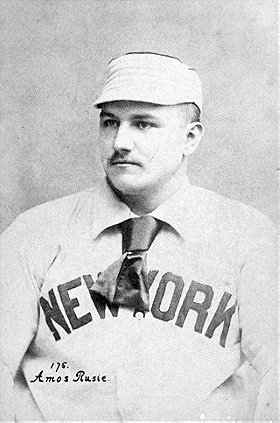Description:
Amos Wilson Rusie (May 30, 1871 – December 6, 1942), nicknamed "The Hoosier Thunderbolt", was a right-handed pitcher during the late 19th century. He had a 10-season career in the National League, which consisted of one season with the Indianapolis Hoosiers in 1889, eight with the New York Giants from 1890 to 1898, and one with the Cincinnati Reds in 1901.
He is best known for the speed in which he pitched a baseball. The velocity of his fastball was unknown, but it has been estimated that he threw it in the mid-to-upper 90s. He led the league in strikeouts five times, and won 20 or more games eight times. Though
Amos Wilson Rusie (May 30, 1871 – December 6, 1942), nicknamed "The Hoosier Thunderbolt", was a right-handed pitcher during the late 19th century. He had a 10-season career in the National League, which consisted of one season with the Indianapolis Hoosiers in 1889, eight with the New York Giants from 1890 to 1898, and one with the Cincinnati Reds in 1901.
He is best known for the speed in which he pitched a baseball. The velocity of his fastball was unknown, but it has been estimated that he threw it in the mid-to-upper 90s. He led the league in strikeouts five times, and won 20 or more games eight times. Though he did throw hard, he did not have good control of his pitches, leading the league in walks five times and being seventh all-time among the career pitching leaders in that category. In 1890 he walked 289, the all-time single-season record.
In 1897, one of his fastballs struck future Hall of Fame shortstop Hughie Jennings in the head, rendering him comatose for four days before recovery. Rusie's wildness had been a catalyst for officials to change the distance from the pitching rubber (the back line of the pitching box at the time) to home plate from 55 feet 6 inches (16.92 m) to the current 60 feet 6 inches (18.44 m). This ruling was made effective for the 1893 season, at the peak of Amos Rusie's pitching prowess. The distance change did not reduce Rusie's effectiveness, as he led the league in strikeouts for three straight seasons afterward, while also winning what later would be known as the pitching triple crown in 1894.
Rusie had worked for ten years in Seattle, WA as a steamfitter, and later in life he returned to Seattle, where he eventually died, in complete obscurity.
Rusie was a forgotten man by the time the BBWAA started Hall of Fame voting in the 1930s. He never received more than 3% of the vote from them. He was eventually elected by the Veterans Committee in 1977. As it was, he barely qualified for the Hall, meeting the minimum requirement of ten seasons only due to his abbreviated final season of three games with Cincinnati. But in spite of that, the numbers he put up in his nine full seasons were outstanding and justify his induction. They would have been even more impressive had he not sat out a full season while in his prime, and a couple more before his unsuccessful comeback in 1901.
For his accomplishments, he was inducted into the Baseball Hall of Fame in 1977 by the Veterans Committee.
Accomplishments:
NL Pitcher's Triple Crown (1894)
2-time NL ERA Leader (1894 & 1897)
NL Wins Leader (1894)
NL Games Pitched Leader (1893)
NL Innings Pitched Leader (1893)
5-time NL Strikeouts Leader (1890, 1891 & 1893-1895)
NL Complete Games Leader (1893)
4-time NL Shutouts Leader (1891 & 1893-1895)
20 Wins Seasons: 8 (1890-1895, 1897 & 1898)
30 Wins Seasons: 4 (1891-1894)
... (more)
(less)
My tags:
 Add tags
Add tags
 United States
United States Login
Login






